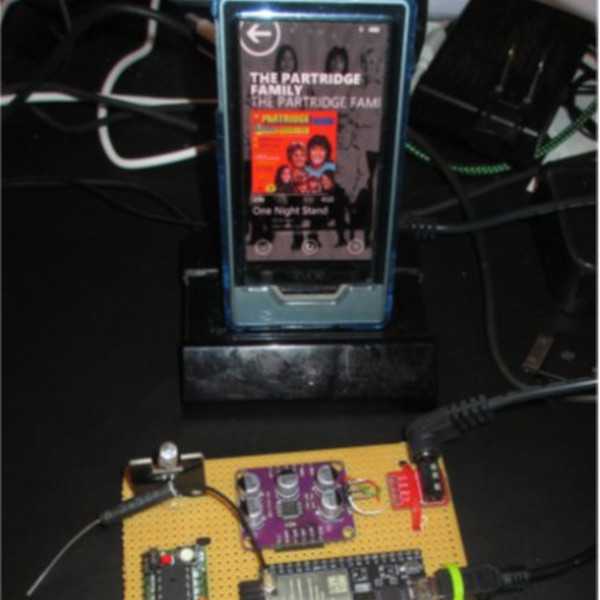The Zune might have joined the portable media player game too late to ever really be competition for the iPod, but that doesn’t mean it didn’t pick up some devoted fans along the way. Some of them are still breathing new life into the device, such as [The Director of Legal Evil Emeritus] at the Louisville Hackerspace, with this project that gives it Bluetooth capability.
As far as media players go, there’s still some solid reasons to rock a Zune. Compared to other devices of the era, it offers a better DAC, an FM tuner, and no iTunes reliance. The goal of this project was to bring a bit of modern functionality without having to do any modification of the Zune itself. As the player supported docks with IR remotes, this build involves using an ESP32 to listen to the Bluetooth signal coming from the speakers, interpret any button presses, and forward them along to the Zune’s dock.
There is a dedicated scene for these old music players, but this build is unique for not needing to crack open the case and splice in a Bluetooth module. Even then, those typically don’t have the ability to interact with things like this speaker with its integrated control buttons.
We don’t often seen Zune hacks come our way — the last time Microsoft’s player graced these pages was in 2010, when the Open Zune Development Kit was released.
Thanks to [JAC_101] for the tip!
















Yeah, Microsoft really screwed up on this one. They quit making it before they added a Bluetooth to the unit. BIG MISTAKE….
Maybe I’m just dense, but I didn’t see anything in the article about how the bluetooth audio functionality was implemented. From the link, the Zune is placed in an ir-remote-equipped dock whose audio output goes (via an i2s adc) to an esp32 programmed as an avrcp-capable (think button-presses) bluetooth transmitter synced to a bluetooth speaker with navigation buttons. The speaker’s navigation button-presses (play/pause, skip F/R, and volume) are intercepted by the esp32, which then sends navigation commands to an arduino equipped with ir-transmitter/ir-receiver circuits. The ir-receiver circuit is used to program the arduino with the original dock remote’s signals, then the arduino uses the ir-transmitter circuit to replay those signals when the BT speaker’s buttons are pressed, with the ir led pointed at the dock’s ir receiver to complete the control loop, so that when buttons on the speaker are pressed, the zune responds accordingly. It’s definitely an interesting way to solve the puzzle, and the fact that it’s non-invasive (and therefore reversible) is meaningful, especially when using vintage hardware like the zune. I’d probably have shoved the whole circuit into the dock itself (and leave out the 4 added buttons and display which seem to be for future upgrades), but for the fact that this setup actually allows swapping input sources, especially if the alternate input sources have ir-remote capability. The whole project seems to be a pretty good example for someone wanting to add bluetooth functionality to vintage equipment, as well as enabling use of the bluetooth device’s remote buttons with the source.
Ok, so the software for the ESP32 has the implementation of an audio Bluetooth transmitter that receives avrcp messages from the speaker that is synced to it and playing the audio. The source code and the necessary libraries are on the original project writeup page.
Why do people do this? There’s no reputation system like on Reddit or Stack Overflow; nothing to be gained. Why submit LLM-authored comments and waste peoples’ time??
(My suspicion is that the first sentence is genuine, and the rest is LLM. I still can’t figure out why, though. Maybe people have a fear of not appearing smart enough in a relatively erudite comments section, and so feel the need to pad their questions with more text?)
Wouldn’t it all work just on ESP32? The second MCU just sends the IR ESP easily can do this effort. 9 components listed, you only need an ESP32, a plug, an ADC and an infrared emitter. Heck, the Zune HD has an optical output, so you don’t really need a headphone jack and an ADC.
Yes, it could all be combined eventually. In the writeup, I mentioned that the library I used for the ir was not compatible with the ESP32. I decided to just offload to an arduino since another ir library i tried didn’t work and so I went for the project finish. As for the optical, that can be part of version 2, with an s/pdif to i2s for the TOSLINK. I appreciate the comments.
hahah this reply actually made me angry while i read it. which is not at all to say i wouldn’t do something just as ridiculous, depending on what tool i happen to have in my hand at the moment. quite the opposite, or my feeling wouldn’t be so genuine! but let me just say, that’s a hack!
Too rushed? Why the rush? Project is so incomplete?
I always feel compelled to mention that, actually, the brown Zune looked great in person.